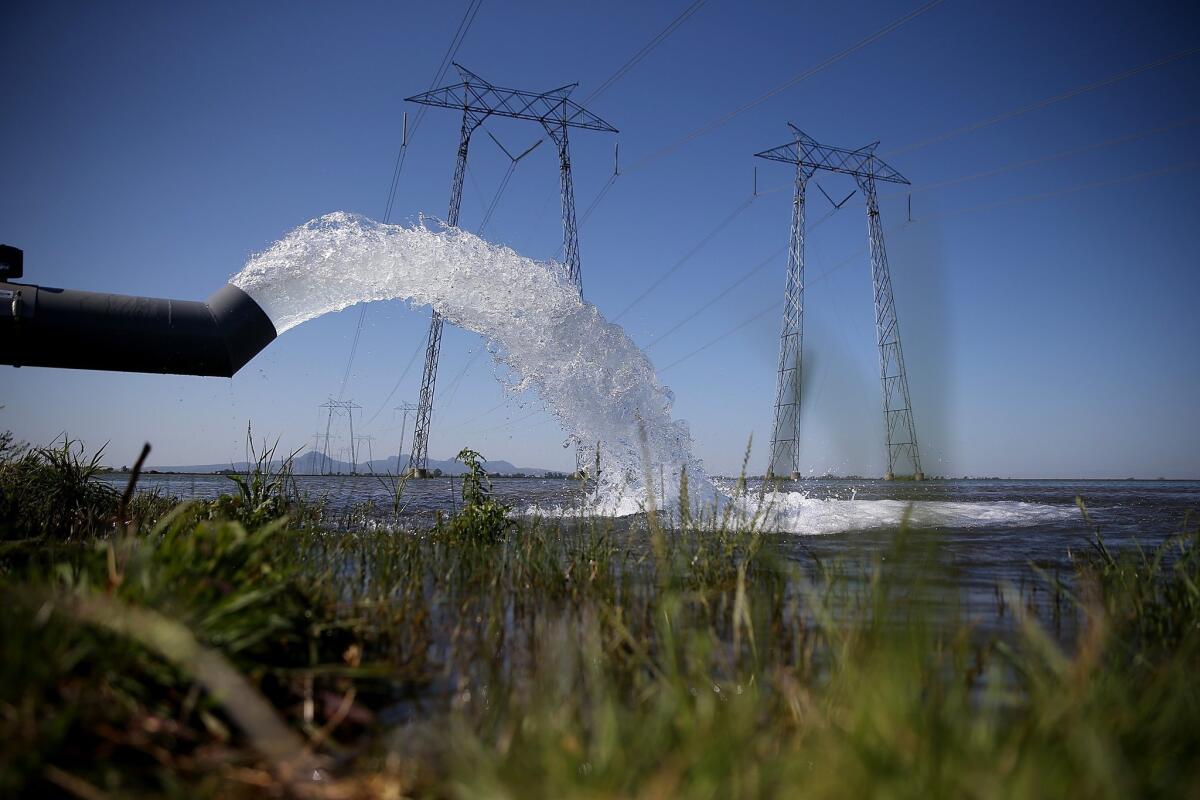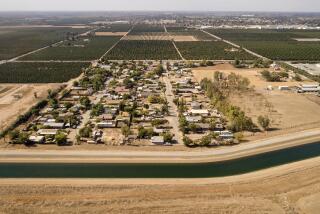Op-Ed: In the water crisis, it’s time to move beyond the farms vs. cities mindset

Water is pumped into a field that will be planted with rice on May 8 in Biggs, Calif. As California enters its fourth year of severe drought, a lack of water has rice farmers cutting back on their annual plantings.
At this point, just about every Californian with a pulse knows that agriculture uses 80% of the state’s water, and cities 20%. This talking point is true as far as it goes, but that’s not very far. You have to limit your vision to the water consumed by humans, “developed” water. This perspective blinds us to the big water picture, and it sets up an unnecessary opposition between farms and cities.
------------
FOR THE RECORD
A previous version of this article misspelled the author’s first name as Nathaniel.
------------
The 80/20 view of California water leaves out the water required to keep riverine fish and riparian habitat alive. It leaves out the freshwater flows needed to keep saltwater from surging into the Sacramento-San Joaquin River Delta. And it leaves out beauty and the gross domestic joy generated by rivers.
Here’s the complete picture: About 50% of California water goes toward maintaining environmental quality, 40% goes to agriculture, and 10% goes to cities (including business uses such as manufacturing). It can be counterintuitive to think of the environment as a water user — after all, that water is “used” only insofar as we leave it in the rivers. But allowing water to flow down rivers to the sea really is an active use with measurable benefits. We devalue the environment if we leave it out of the equation. And we can’t judge the arguments for and against such uses if we don’t acknowledge that they exist.
Still, it’s the ag/urban split that sticks in our minds. Whether the figure is 80% or 40%, the fact that farms use so much more water than cities evokes fury from those who see farmers as robber barons, converting a natural resource into private fortunes. There’s a growing populist sentiment that irrigation water is simply making rich farmers richer.
This is by no means self-evident. It’s worth noting that public sentiment was once precisely reversed and irrigation was seen as a democratizing force.
In 1870, giant dry-farmed wheat estates and cattle ranches dominated the Central Valley. But with irrigation, a family farmer could make a living on as little as 10 acres selling vegetables, fruit and nuts. At that time, Californians saw irrigation as a way to break up the land monopolies and foster Jeffersonian farmers.
The reality, of course, is complex. In the beginning, irrigation enriched the monopolists even more than small farmers, but as Norris Hundley Jr. shows in his history of the state’s water, “The Great Thirst,” it also built up an agricultural middle class in places such as Fresno, Merced and Stockton. Irrigated agriculture provided for the egalitarian beginnings of Anaheim, Riverside and Ontario. It has been the means by which many immigrants — German, Swiss, Armenian, Hmong and Mexican — have made their stake in California.
And the situation remains complex today: Irrigation water supports millionaires with giant tracts of land and middle-class family farmers alike.
Another reason the 80% figure has gone viral is that it contains an uncomfortable truth: It takes a lot of water to grow food. Contrary to conventional wisdom, drip-irrigation systems and micro sprinklers do very little to change a crop’s consumption of water. It’s true that less-efficient techniques like flood irrigation use more water, but what isn’t required by the plants isn’t lost, it goes down into the aquifer or back into the river. Increasing the organic matter in soil — with techniques such as composting, mulching and reduced plowing — can improve water retention and lessen water use. But the lion’s share of irrigation water goes into the plants, and that’s hard to change. In the end, any cuts to irrigation mean less food production.
Less food production means less economic activity. That’s not cause for panic: Agriculture accounts for just 2% of California’s massive economy. Nonetheless, California has the highest agriculture sales of any state, and those sales are the bulwark of many poorer counties. There are really two Californias: a wealthy coast and a poor inland that relies heavily on farmers.
Whenever there is a drought, farmers suffer first — they idle land, pump groundwater. Each year, farmers have been pumping up more water than seeps down, but a law passed last year will change that. There will be even less water for farmers as the new regulations put an end to groundwater mining and the climate warms. There’s no getting around it: Those cutbacks will hurt.
In cities, by contrast, residents can cut water consumption with much less pain. Los Angeles has kept its water consumption flat since the 1980s while adding a million residents, thanks to improved technology (low-flow toilets!) and improved landscaping (these dry gardens are far more beautiful than turf, in my humble opinion).
In a moment of crisis, it’s human nature to look for villains: Liberals against conservatives, north against south, farms against cities. The 80/20 statistic neatly — far too neatly — defines the conflict. But is the objective to define our enemies and triumph over them, or do we want to find solutions for the greater commonwealth?
If it’s the latter, we should watch to ensure that our new groundwater law results in rules for real sustainability, move swiftly to restore water to residents whose wells have gone dry, step up our water conservation efforts and stop thinking in terms of them versus us. Most important, we must continue California’s leadership in fighting climate change. It’s misleading to zero in on part of the picture: If we want holistic solutions, we have to take the holistic view.
Nathanael Johnson, a Bay Area journalist, writes the “Thought for Food” column at Grist.org. He is the author of “All Natural” and a contributor to Harper’s Magazine, New York and “This American Life.” Twitter: @SavorTooth.
Follow the Opinion section on Twitter @latimesopinion and Facebook
More to Read
A cure for the common opinion
Get thought-provoking perspectives with our weekly newsletter.
You may occasionally receive promotional content from the Los Angeles Times.










